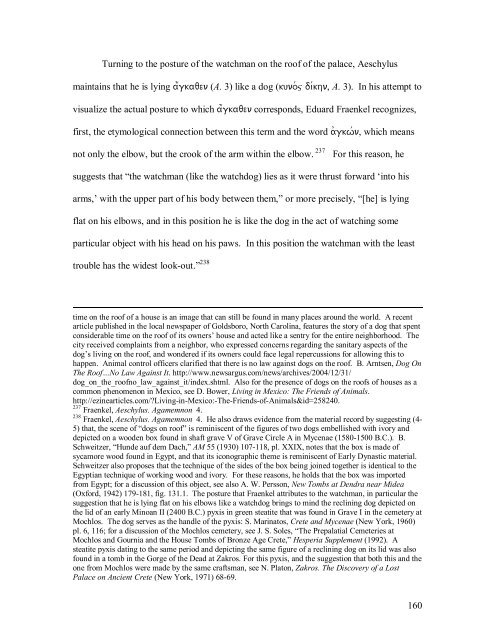The Judgment of Animals in Classical Greece: Animal Sculpture and ...
The Judgment of Animals in Classical Greece: Animal Sculpture and ...
The Judgment of Animals in Classical Greece: Animal Sculpture and ...
Create successful ePaper yourself
Turn your PDF publications into a flip-book with our unique Google optimized e-Paper software.
Turn<strong>in</strong>g to the posture <strong>of</strong> the watchman on the ro<strong>of</strong> <strong>of</strong> the palace, Aeschylus<br />
ma<strong>in</strong>ta<strong>in</strong>s that he is ly<strong>in</strong>g a1gkaqen (A. 3) like a dog (kuno&j di/khn, A. 3). In his attempt to<br />
visualize the actual posture to which a1gkaqen corresponds, Eduard Fraenkel recognizes,<br />
first, the etymological connection between this term <strong>and</strong> the word a)gkw&n, which means<br />
not only the elbow, but the crook <strong>of</strong> the arm with<strong>in</strong> the elbow. 237 For this reason, he<br />
suggests that “the watchman (like the watchdog) lies as it were thrust forward ‘<strong>in</strong>to his<br />
arms,’ with the upper part <strong>of</strong> his body between them,” or more precisely, “[he] is ly<strong>in</strong>g<br />
flat on his elbows, <strong>and</strong> <strong>in</strong> this position he is like the dog <strong>in</strong> the act <strong>of</strong> watch<strong>in</strong>g some<br />
particular object with his head on his paws. In this position the watchman with the least<br />
trouble has the widest look-out.” 238<br />
time on the ro<strong>of</strong> <strong>of</strong> a house is an image that can still be found <strong>in</strong> many places around the world. A recent<br />
article published <strong>in</strong> the local newspaper <strong>of</strong> Goldsboro, North Carol<strong>in</strong>a, features the story <strong>of</strong> a dog that spent<br />
considerable time on the ro<strong>of</strong> <strong>of</strong> its owners’ house <strong>and</strong> acted like a sentry for the entire neighborhood. <strong>The</strong><br />
city received compla<strong>in</strong>ts from a neighbor, who expressed concerns regard<strong>in</strong>g the sanitary aspects <strong>of</strong> the<br />
dog’s liv<strong>in</strong>g on the ro<strong>of</strong>, <strong>and</strong> wondered if its owners could face legal repercussions for allow<strong>in</strong>g this to<br />
happen. <strong>Animal</strong> control <strong>of</strong>ficers clarified that there is no law aga<strong>in</strong>st dogs on the ro<strong>of</strong>. B. Arntsen, Dog On<br />
<strong>The</strong> Ro<strong>of</strong>…No Law Aga<strong>in</strong>st It. http://www.newsargus.com/news/archives/2004/12/31/<br />
dog_on_the_ro<strong>of</strong>no_law_aga<strong>in</strong>st_it/<strong>in</strong>dex.shtml. Also for the presence <strong>of</strong> dogs on the ro<strong>of</strong>s <strong>of</strong> houses as a<br />
common phenomenon <strong>in</strong> Mexico, see D. Bower, Liv<strong>in</strong>g <strong>in</strong> Mexico: <strong>The</strong> Friends <strong>of</strong> <strong><strong>Animal</strong>s</strong>.<br />
http://ez<strong>in</strong>earticles.com/?Liv<strong>in</strong>g-<strong>in</strong>-Mexico:-<strong>The</strong>-Friends-<strong>of</strong>-<strong><strong>Animal</strong>s</strong>&id=258240.<br />
237 Fraenkel, Aeschylus. Agamemnon 4.<br />
238 Fraenkel, Aeschylus. Agamemnon 4. He also draws evidence from the material record by suggest<strong>in</strong>g (4-<br />
5) that, the scene <strong>of</strong> “dogs on ro<strong>of</strong>” is rem<strong>in</strong>iscent <strong>of</strong> the figures <strong>of</strong> two dogs embellished with ivory <strong>and</strong><br />
depicted on a wooden box found <strong>in</strong> shaft grave V <strong>of</strong> Grave Circle A <strong>in</strong> Mycenae (1580-1500 B.C.). B.<br />
Schweitzer, “Hunde auf dem Dach,” AM 55 (1930) 107-118, pl. XXIX, notes that the box is made <strong>of</strong><br />
sycamore wood found <strong>in</strong> Egypt, <strong>and</strong> that its iconographic theme is rem<strong>in</strong>iscent <strong>of</strong> Early Dynastic material.<br />
Schweitzer also proposes that the technique <strong>of</strong> the sides <strong>of</strong> the box be<strong>in</strong>g jo<strong>in</strong>ed together is identical to the<br />
Egyptian technique <strong>of</strong> work<strong>in</strong>g wood <strong>and</strong> ivory. For these reasons, he holds that the box was imported<br />
from Egypt; for a discussion <strong>of</strong> this object, see also A. W. Persson, New Tombs at Dendra near Midea<br />
(Oxford, 1942) 179-181, fig. 131.1. <strong>The</strong> posture that Fraenkel attributes to the watchman, <strong>in</strong> particular the<br />
suggestion that he is ly<strong>in</strong>g flat on his elbows like a watchdog br<strong>in</strong>gs to m<strong>in</strong>d the recl<strong>in</strong><strong>in</strong>g dog depicted on<br />
the lid <strong>of</strong> an early M<strong>in</strong>oan II (2400 B.C.) pyxis <strong>in</strong> green steatite that was found <strong>in</strong> Grave I <strong>in</strong> the cemetery at<br />
Mochlos. <strong>The</strong> dog serves as the h<strong>and</strong>le <strong>of</strong> the pyxis: S. Mar<strong>in</strong>atos, Crete <strong>and</strong> Mycenae (New York, 1960)<br />
pl. 6, 116; for a discussion <strong>of</strong> the Mochlos cemetery, see J. S. Soles, “<strong>The</strong> Prepalatial Cemeteries at<br />
Mochlos <strong>and</strong> Gournia <strong>and</strong> the House Tombs <strong>of</strong> Bronze Age Crete,” Hesperia Supplement (1992). A<br />
steatite pyxis dat<strong>in</strong>g to the same period <strong>and</strong> depict<strong>in</strong>g the same figure <strong>of</strong> a recl<strong>in</strong><strong>in</strong>g dog on its lid was also<br />
found <strong>in</strong> a tomb <strong>in</strong> the Gorge <strong>of</strong> the Dead at Zakros. For this pyxis, <strong>and</strong> the suggestion that both this <strong>and</strong> the<br />
one from Mochlos were made by the same craftsman, see N. Platon, Zakros. <strong>The</strong> Discovery <strong>of</strong> a Lost<br />
Palace on Ancient Crete (New York, 1971) 68-69.<br />
160

















